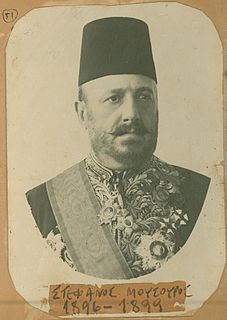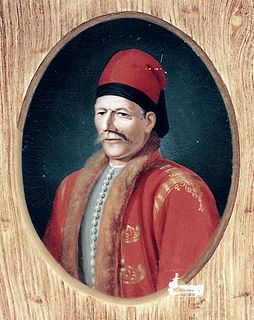
The North Aegean is one of the thirteen administrative regions of Greece. It comprises the islands of the north-eastern Aegean Sea, called the North Aegean islands, except for Thasos and Samothrace, which belong to the Greek region of Eastern Macedonia and Thrace, and Imbros and Tenedos, which belong to Turkey.
Samos is a Greek island in the eastern Aegean Sea.

Vathy is a town and a former municipality on the island of Samos, North Aegean, Greece. Since the 2011 local government reform it is part of the municipality Samos, of which it is a municipal unit. It is the capital and main town of the island. The municipal unit has an area of 125.153 km2. The municipal unit comprises numerous towns, villages, and settlements, but its two largest are Samos (town), and Vathy. The town of Samos is the largest on the island, and the heart of its economy based on tourism. Vathy is a sister city of Kuşadası, Turkey since October 28, 1999.
Kokkari is a village on Samos Island, Greece, about 10 kilometers from the capital city, Vathy.

Samo is a small town and comune located in the Province of Reggio Calabria, southern Italy. Samo has a population of 1,090 but this increases seasonally. Samo is about 10 kilometres (6 mi) inland and about 390 metres (1,280 ft) above sea level. It is located at the foot of Aspromonte National Park.

Platanos is a village and a former municipality in Aetolia-Acarnania, West Greece, Greece. Since the 2011 local government reform it is part of the municipality Nafpaktia, of which it is a municipal unit. The municipal unit has an area of 169.678 km2. Population 1,611 (2011). The population of the village was 207 in 2011 and the population of the municipal district, which includes the village Kato Platanos, was 253. The river Evinos is situated east of the town.

Greek dances (horos) is a very new tradition, being referred to by authors such as Plato, Aristotle, Plutarch and Lucian. There are different styles and interpretations from all of the islands and surrounding mainland areas. Each region formed its own choreography and style to fit in with their own ways. For example, island dances have more of a different smooth flow to them, while Pontic dancing closer to Black Sea, is very sharp. There are over 10 000 traditional dances that come from all regions of Greece. There are also pan-Hellenic dances, which have been adopted throughout the Greek world. These include the syrtos, kalamatianos, pyrrhichios, hasapiko and sirtaki.

The Kalamatianós is one of the best known dances of Greece. It is a popular Greek folkdance throughout Greece, Cyprus and internationally and is often performed at many social gatherings worldwide. As is the case with most Greek folk dances, it is danced in chain with a counterclockwise rotation, the dancers holding hands.

Platanos is a village and a community in the municipal unit of Akrata, Achaea, Greece. In 2011 Platanos had a population of 231 for the village, and 259 for the community, which includes the mountain villages Ano Potamia, Korinthiako Balkoni and Tsivlos. The village Platanos consists of two parts: the seaside settlement Paralia Platanou on the Gulf of Corinth and Platanos proper at about 250 m elevation on a mountain slope directly above Paralia Platanou. The villages Ano Potamia and Tsivlos are about 10 km south of Platanos. Platanos is 5 km west of Akrata and 18 km southeast of Aigio. The Greek National Road 8A and the railway Corinth - Patras pass north of Platanos.

The music of Epirus, in Epirus, northwestern Greece, present to varying degree in the rest of Greece and the islands, contains folk songs that are mostly pentatonic and polyphonic, characterized as relaxed, gentle and exceptionally beautiful, and sung by both male and female singers.

Platanos is a village and a community in the municipality of Ancient Olympia, Elis, Greece. It is located north of the Alfeios valley, 2 km southeast of Pelopio, 3 km northwest of Olympia and 15 km east of Pyrgos. The Greek National Road 74 passes south of Platanos. In 2011 Platanos had a population of 766 for the village, and 780 for the community, which includes the small village Agios Georgios.

The island of Samos had participated in the Greek War of Independence and had successfully resisted several Turkish and Egyptian attempts to occupy it, but it was not included with the boundaries of the newly independent Kingdom of Greece after 1832. Instead, in 1834 the island was granted self-government as a semi-independent state, the Principality of Samos.

The Military-Political System of Samos was a provisional regime that existed in the island of Samos during the Greek War of Independence.
Vayia Strose kai Louloudia is a dance from the Island of Samos. It is similar in style to the Syrtos dance. Its name is derived from a famous Samian Poet named Sideris Zisimou.

Stephanos Mousouros was the Ottoman-appointed Prince of Samos from 1896 to 1899.

Konstantinos Karatheodoris was a member of the distinguished Phanariote Karatheodori family. He served as the Ottoman-appointed Prince of Samos from 1906 to 1907. He was the younger brother of the diplomat and statesman Alexander Karatheodori Pasha, who also served as Prince of Samos from 1885 to 1895.

Lykourgos Logothetis, born Georgios Paplomatas, was a Samian who became the island's leader during the Greek War of Independence.









